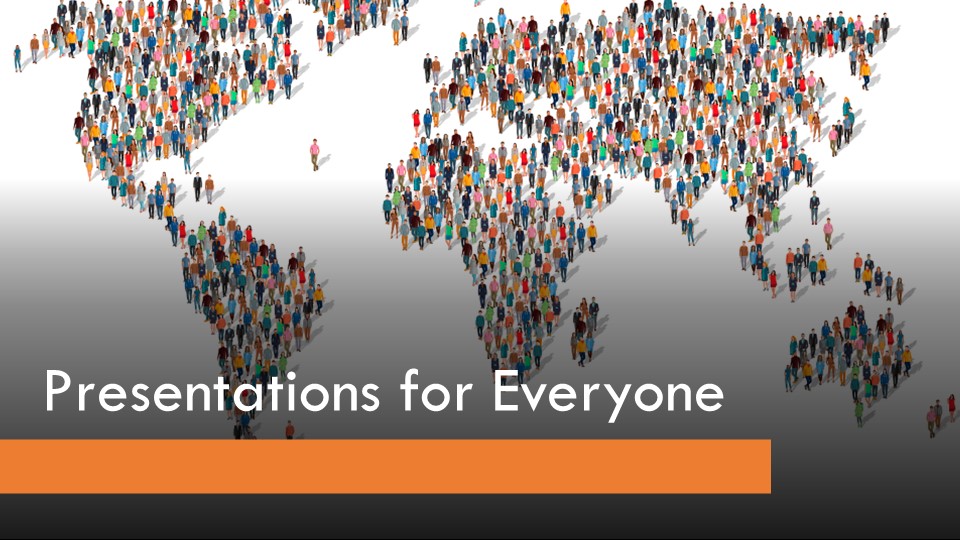I began my journey as an accessibility advocate over 20 years ago when I was asked to find out how to make Microsoft Office files comply with Section 508 of the American Disabilities Act (ADA). At the time no one knew how to do that, not even Microsoft. I collaborated with disabled colleagues to find and document the steps needed to make Office files accessible. That led to my earning the Microsoft MVP award in January 2004.
The famous quote says, “You can please some of the people all of the time, you can please all of the people some of the time, but you can’t please all of the people all of the time.” In this series of posts, I want to tell you why you should try to please all the people and how you can make your presentations accessible.
Accessibility is Good for Business
According to the Centers for Disease Control and Prevention (CDC) 61 million Americans live with some form of disability. That is 26%, more than one quarter or one out of every four persons. In the United Kingdom (UK), 19% or one in five working adults have a disability.
An American Institutes for Research 2018 report, A Hidden Market: The Purchasing Power of Working-Age Adults with Disabilities, found that the total disposable incomes for working-age persons with disabilities is almost $500 billion. That is comparable to the African American or Hispanic markets. Although their disposable income is slightly lower than other minority groups, after covering taxes and necessities, the discretionary income for working-aged people with disabilities was $21 billion. That is higher than the African American and Hispanic markets combined.
In the UK, the spending power of disabled people and their household continues to increase and is currently (2020) estimated to be worth £274 billion per year to UK business and businesses lose approximately £2 billion a month by ignoring the needs of disabled people.
The US Cause Marketing Market Report 2018 shows that Americans love a company that supports a cause. Half (50%) of Americans say that they would switch to a company that supports a cause they believe in, rising to 61% of adult iGeneration consumers (aged 18-23) and Millennials (aged 24-41), respectively. Nearly two-thirds believe it is a company’s responsibility to give back (65%) and to have a moral or ethical viewpoint (64%), while around half expect brands to improve the local community (53%) and donate proceeds to charity (49%).
The global disabled community is a huge market and ignoring its potential is bad for business.
We are not Getting Younger
Each of us has about two out of three chances of experiencing a functional limitation in our lifetime. Data from 2010 – 2018 from the National Center for Health Statistics shows that while 30% of adults aged 18 – 64 have trouble in the six domains of functioning (Seeing, Hearing, Mobility, Cognition, Communication, Self-Care), that percentage jumps to 70% for adults 65 and older. And those numbers are increasing for all ages as more functional limitations are identified.


Accessibility is the right thing to do for others and yourself.
Accessibility Benefits Everyone
You may not realize it, but we use assistive technology every day. Pellegrino Turri invented a mechanical typing machine, one of the first typewriters, at the start of the 19th century for his blind friend to send him letters. Alexander Graham Bell was motivated by his deaf wife when creating the telephone.
Every day we talk to our phones, watch foreign films with subtitles, drag our luggage over curb cuts, and type on our keyboards. This is known as the Curb-Cut Effect, a vibrant illustration of how laws and programs designed to benefit vulnerable groups, such as the disabled or people of color, often end up benefiting all. The Curb-Cut Effect, in its essence, asserts that an investment in one group can cascade out and up and be a substantial investment in the broader well-being of a nation — one whose policies and practices create an equitable economy, a healthy community of opportunity, and just society.
True accessibility goes even further. It means trying to overcome all functional limitations with your presentations, such as reaching that person with limited internet access. When crafting your presentations, imagine all scenarios, reach for pleasing all the people all the time.
So how do we do that? In my next article in this series, I’ll address exactly what accessibility means and how to incorporate it into your process. Subsequent articles will address the tools and techniques to ensure your presentations are accessible for everyone.

